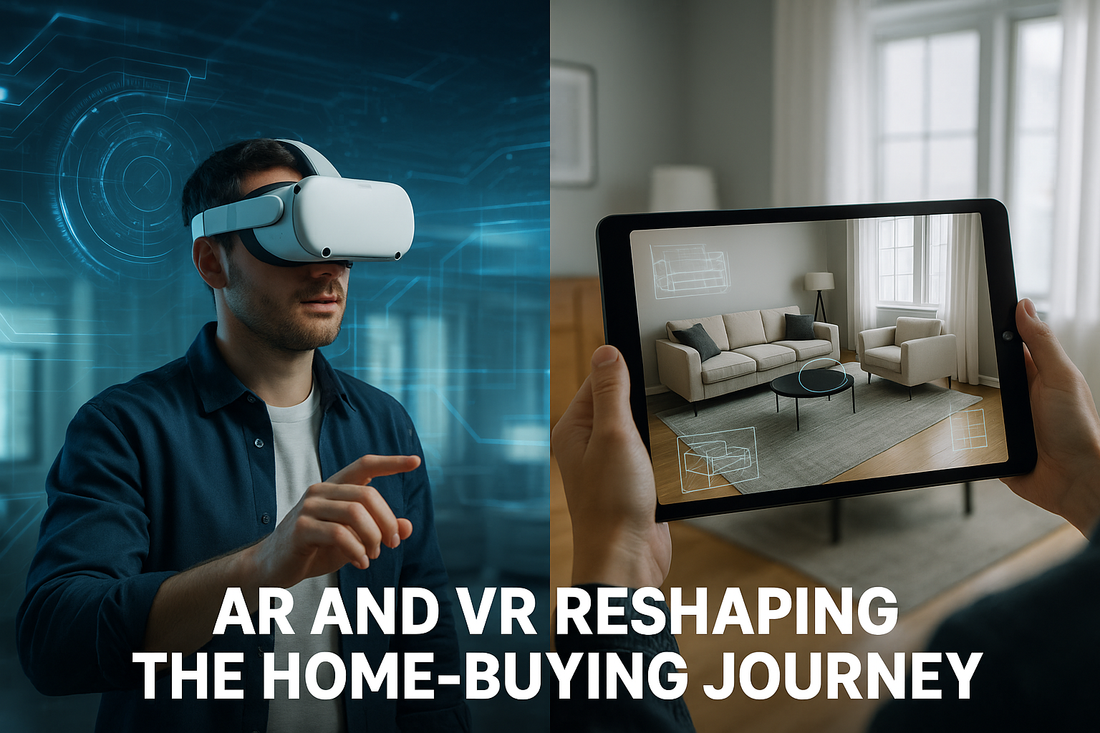
How AR and VR Are Reshaping the Home-Buying Journey
Share
The real estate industry has always been driven by the buyer’s imagination: envisioning how a space might look, feel, and function. Traditionally, buyers relied on photos, floor plans, and in-person visits to make decisions. Today, however, technology is transforming this process. Augmented Reality (AR) and Virtual Reality (VR) are no longer futuristic concepts—they are practical tools that are reshaping how people buy homes. By providing immersive, interactive experiences, AR and VR are bridging the gap between imagination and reality, making the home-buying journey faster, more informed, and more engaging.
Understanding AR and VR in Real Estate
Virtual Reality (VR)
VR creates a fully digital, three-dimensional environment that allows buyers to explore properties without physically being there. Using VR headsets or compatible devices, buyers can "walk" through homes, view layouts, and assess space and flow as if they were on-site.
Augmented Reality (AR)
AR overlays digital elements onto the real world, enhancing a buyer’s view of a property. For instance, buyers can point their smartphones at an empty room and see virtual furniture, wall colors, or decor in real time. AR transforms how buyers interact with a property, making it highly personalized and visually compelling.
How AR and VR Transform the Home-Buying Journey
1. Immersive Property Exploration
VR allows buyers to tour entire homes from anywhere in the world. They can navigate rooms at their own pace, inspect details, and get a realistic sense of space. This is especially valuable for international buyers, busy professionals, or those relocating from another city, eliminating the need for multiple in-person visits.
2. Visualizing Potential
One of the biggest challenges for buyers is imagining how a blank or outdated space can be transformed. AR solves this by enabling virtual staging, allowing buyers to experiment with furniture, color schemes, or layouts. This capability helps buyers see the full potential of a property, making them more likely to engage seriously.
3. Reducing Decision-Making Time
AR and VR provide instant, comprehensive insights into a property. Instead of scheduling multiple showings or relying on imagination, buyers can experience homes digitally and make confident decisions faster. Faster, informed decisions benefit both buyers and sellers by shortening the time-on-market.
4. Increasing Engagement and Emotional Connection
Immersive experiences evoke stronger emotional responses than static photos or videos. Buyers can "walk through" a sunlit living room, explore a backyard, or visualize family gatherings in a dining space. This emotional connection increases the likelihood of offers and accelerates the sales process.
5. Enhanced Marketing for Agents
For real estate agents, AR and VR provide a competitive edge. Properties marketed with immersive technologies stand out online, attract more qualified leads, and demonstrate professionalism. Interactive tours can be shared on social media, embedded on websites, or sent to email lists, expanding reach and engagement.
Case Examples of AR and VR in Action
-
Virtual Open Houses: Agents can host live VR tours where multiple buyers explore the property simultaneously and ask questions in real time.
-
AR Interior Customization: Buyers can use AR apps to virtually repaint walls, replace flooring, or rearrange furniture to match their style preferences.
-
Remote Property Viewing: Out-of-town buyers can fully experience a property remotely, enabling cross-border transactions without multiple trips.
These tools not only improve buyer experience but also reduce logistical costs and resource usage for agents and sellers.
The Broader Impact on the Industry
AR and VR are changing expectations. Buyers now anticipate immersive experiences as part of the home search process. Properties without interactive tours risk losing attention to tech-savvy competitors. For agents, embracing these technologies enhances credibility, improves client satisfaction, and accelerates the sales cycle.
Moreover, AR and VR contribute to sustainable practices in real estate. Virtual staging reduces the need for physical furniture, decor, and repeated in-person showings, lowering environmental impact while still delivering stunning marketing results.
Looking Ahead
As AR and VR continue to advance, their role in real estate will only expand. AI-powered virtual tours may adapt dynamically to buyer preferences, allowing for fully personalized experiences. Mixed-reality platforms could enable buyers to walk through partially completed developments or experiment with remodeling options digitally before making a purchase.
The future of home-buying is interactive, immersive, and digitally driven. Agents who embrace AR and VR will not only meet buyer expectations but also redefine how properties are experienced and sold.
Final Thoughts
AR and VR are no longer optional tools—they are essential elements of a modern, effective home-buying experience. By making properties more accessible, engaging, and visually compelling, these technologies enhance buyer confidence, reduce decision-making time, and strengthen emotional connection.
For buyers, AR and VR turn imagination into reality. For agents, they provide a competitive advantage that accelerates sales, builds credibility, and elevates marketing. In a digital-first world, immersive technology is reshaping the home-buying journey—and those who adopt it today will lead the market tomorrow.
